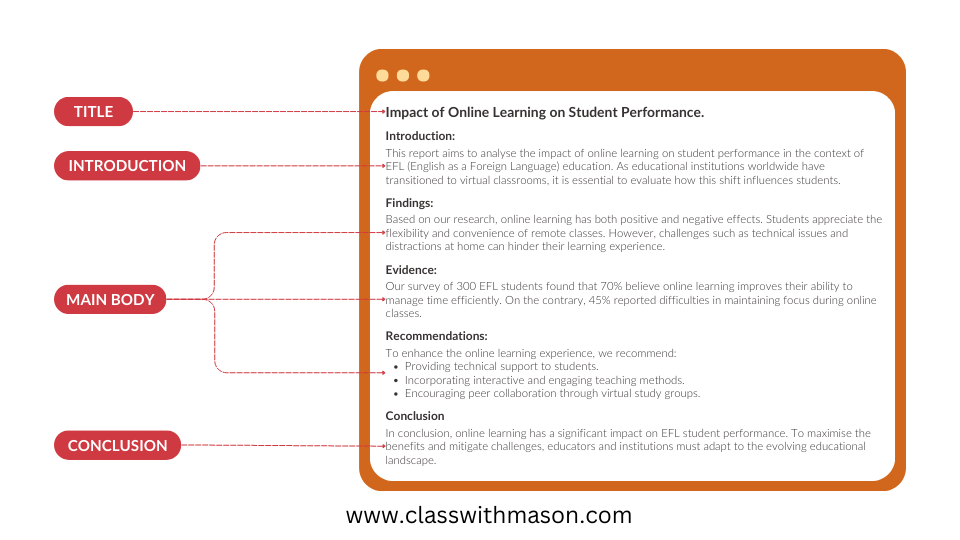What is a Report?
A report is a meticulously crafted formal document designed to convey information in a structured and organized manner. Its primary purpose is to inform, analyze, or persuade, often presenting findings, data, or recommendations. Despite its formality, a well-crafted report can be a powerful tool in various contexts, both professional and personal.
Mobile-First Slides
Report Writing IRL (In Real Life)
Report writing extends beyond academic realms; it is a fundamental skill with practical implications in diverse real-life scenarios. Whether in business, politics, academia, or everyday life, the ability to articulate information clearly and concisely is a valuable asset, contributing to effective communication and decision-making.
Language & Style: Reports demand a formal and neutral language, maintaining an impersonal tone to present information objectively. While personal opinions are generally avoided, a judicious use of persuasive language can be employed, especially when making recommendations or arguing a specific viewpoint.
Key Elements of a Report
- Title: A clear and concise title sets the tone for the entire report, offering a preview of its content.
- Introduction: An effective introduction serves as a roadmap, introducing the topic, establishing its significance, and stating the purpose of the report.
- Main Body: This section delves into the core of the report, presenting a detailed exploration of ideas, supported by facts, findings, or analysis.
- Conclusion: The conclusion summarizes key findings, reiterates the purpose, and often provides recommendations or future considerations.
Structure & Organization
- Use of Sub-headings: Employing sub-headings organizes the report into distinct sections, facilitating easy navigation and comprehension for the reader.
- Bulleted Lists: Incorporating bulleted lists aids in presenting key points or supporting evidence succinctly, enhancing readability and emphasis.
- Logical Flow: Ensuring a logical flow from one section to the next is paramount. A seamless transition enhances the overall coherence and impact of the report.
Report Example: Impact of Online Learning on EFL Student Performance
Introduction:
This report aims to conduct a nuanced analysis of the impact of online learning on student performance in the context of EFL (English as a Foreign Language) education. The global shift towards virtual classrooms necessitates a comprehensive evaluation of its effects on students.
Findings:
Our research reveals a nuanced perspective on online learning, acknowledging both positive and negative effects. While students appreciate the flexibility and convenience, challenges such as technical issues and home distractions pose potential obstacles to their learning experience.
Evidence:
Our survey of 300 EFL students provides concrete evidence of this dual impact. Notably, 70% believe online learning enhances their time management skills, yet 45% report challenges in maintaining focus during virtual classes.
Recommendations:
- Providing Technical Support: Institutions should offer robust technical assistance to students to address challenges related to online learning platforms.
- Incorporating Interactive Methods: Educators should explore interactive and engaging teaching methods to enhance the online learning experience.
- Encouraging Peer Collaboration: Virtual study groups can be promoted to foster peer collaboration, addressing potential feelings of isolation.
Conclusion:
In conclusion, the impact of online learning on EFL student performance is multifaceted. To optimize the benefits and mitigate challenges, educators and institutions must adapt dynamically to the evolving educational landscape, ensuring a balanced and effective learning environment.
Key Sections in a Report:
- Purpose: Clearly articulate the objective or intention behind the report, setting the stage for reader expectations.
- Findings: Present discovered information comprehensively, ensuring accuracy, relevance, and a clear connection to the report's purpose.
- Evidence: Substantiate findings with context, facts, and data, enhancing the report's credibility and persuasiveness.
- Recommendation: Offer practical and well-supported suggestions based on the outcomes of the report, addressing identified issues.
- Summary: Recapitulate essential points, reinforcing the significance of the report's findings and recommendations.
- Context: Provide background or context to help readers understand the subject matter, fostering a deeper comprehension.
- Facts/Data: Integrate relevant statistics or data strategically to strengthen the report's credibility and persuasiveness.
- Final Remarks: Conclude with insightful remarks that leave a lasting impression, encouraging further reflection or action.











